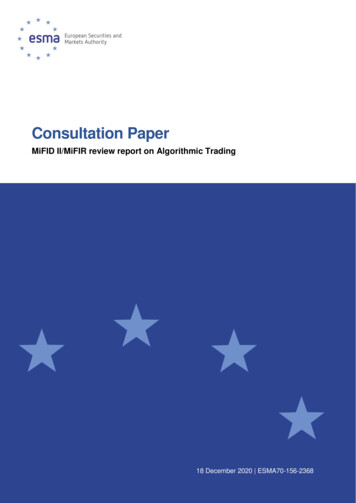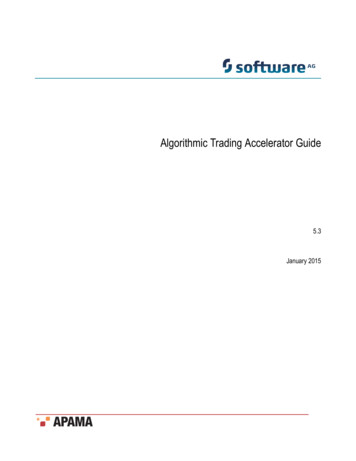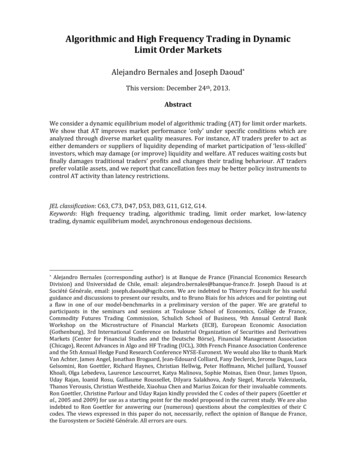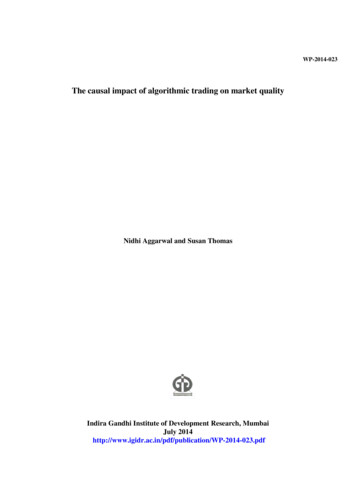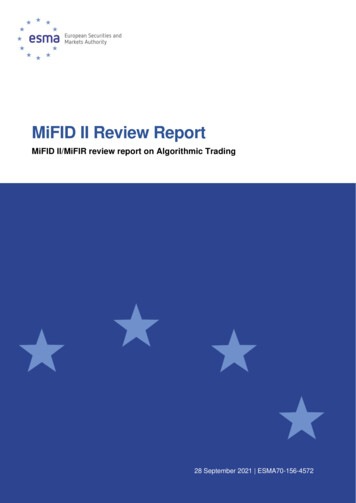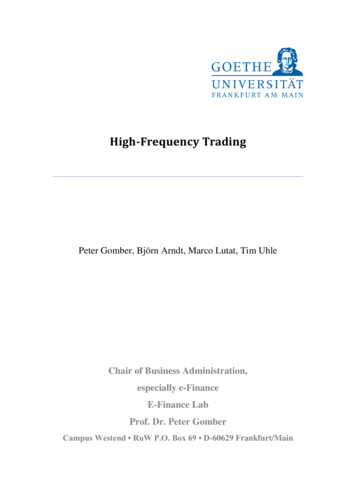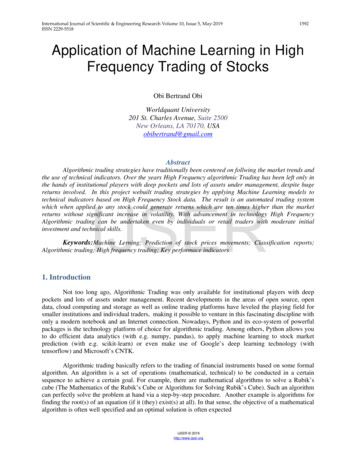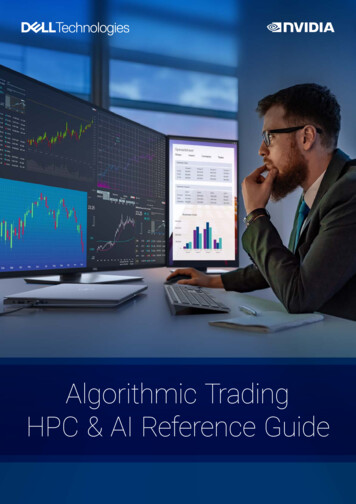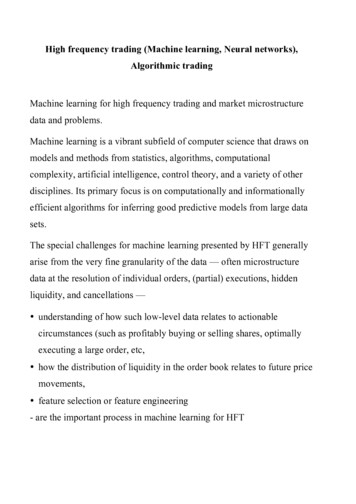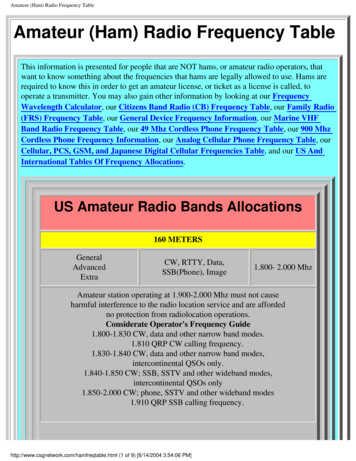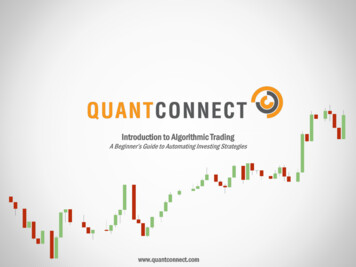
Transcription
NBER WORKING PAPER SERIESHIGH-FREQUENCY, ALGORITHMIC SPILLOVERS BETWEEN NASDAQ ANDFOREXTakatoshi ItoMasahiro YamadaWorking Paper 21122http://www.nber.org/papers/w21122NATIONAL BUREAU OF ECONOMIC RESEARCH1050 Massachusetts AvenueCambridge, MA 02138April 2015Ito acknowledges financial support Grant-in-Aid for Scientific Research A-25245044. We thank FrankHatheway (Nasdaq OMX) for providing Nasdaq OMX data. The views expressed herein are thoseof the authors and do not necessarily reflect the views of the National Bureau of Economic Research.NBER working papers are circulated for discussion and comment purposes. They have not been peerreviewed or been subject to the review by the NBER Board of Directors that accompanies officialNBER publications. 2015 by Takatoshi Ito and Masahiro Yamada. All rights reserved. Short sections of text, not to exceedtwo paragraphs, may be quoted without explicit permission provided that full credit, including notice,is given to the source.
High-frequency, Algorithmic Spillovers Between NASDAQ and ForexTakatoshi Ito and Masahiro YamadaNBER Working Paper No. 21122April 2015JEL No. F31,G12,G14,G15,G23ABSTRACTWe empirically examine the order flows spillovers between Nasdaq and the Forex markets in 2008and 2009. With emphasis on a role of high-frequency traders (HFTs) who aggregate information betweenthe two markets as well as within each market, our results show that HFTs in Nasdaq trade intensivelyon the market-wide information more rapidly than other market participants, and that their order flowscontain more information about the Forex rates than those of the Forex themselves. As a result, orderflows by HFTs in Nasdaq significantly lead those in the Forex activities. Reflecting each market'sexposures to the common shocks during the Global Financial crisis, these spillovers vary over time,and HFTs have increased their influences. These empirical results are consistent with theoretical predictionsof the rational expectations model of multi-asset trading.Takatoshi ItoColumbia UniversitySchool of International and Public AffairsInternational Affairs BuildingRoom 927, (MC 3333)420 West 118th StreetNew York, NY 10027and NBERti2164@columbia.eduMasahiro YamadaHitotsubashi University2-1 NakaKunitachi, Tokyo, 186-8601Japanm.yamada@r.hit-u.ac.jp
1IntroductionRecently, behavior of high-frequency traders (HFTs) becomes a focus of intensive examination among practitioners, regulators, as well as academics. Although there is a growingliterature of HFTs in individual assets, their spillovers across different markets have not beeninvestigated in the literature. In this study, using a dataset that identifies transactions byHFTs in Nasdaq OMX, we explore the spillovers between Nasdaq stock market and Foreignexchange (Forex) markets. We find that HFTs trade on the common information more aggressively and rapidly than non-HFTs and their order flows contain more information aboutthe Forex rates than those of the Forex themselves.Stock prices and Forex rates are correlated. Figure 1 plots three Forex rates (EUR/JPY,EUR/USD, USD/JPY), Nasdaq index, and the volume share of Nasdaq HFTs from January2008 to August 2009. The plots shows that the correlation between Forex rates and thestock index are time-varying. After September 2008, the correlation seems increased as thevolume share of HFTs rose. Then, what is the role of HFT in the determination of thecorrelation between stocks and Forex? Recent studies on HFTs show that HFTs trade in thesame direction of permanent price changes and contribute to the price discovery as a marketmaker (Hirschey (2013); Menkveld (2013); Hendershott (2011); Carrion (2013); Brogaard,Hendershott and Riordan (2012)), but they do not investigate the spillovers of HFTs toother markets or the source of better price discovery by HFTs.We aim to answer HFT’s role in influencing cross-market correlation. To do so, wecombine Nasdaq OMX high-frequency trader dataset and EBS Forex dataset. Nasdaq datasetidentifies transactions by HFTs, allowing an analysis on HFTs as a group. By using thedataset, we compare market-wide order flows in Nasdaq and Forex activities. A standardvector auto-regression (VAR) is used to investigate the lead-lag, cross-price impacts, and theinformation share of order flows among order flows in the Forex, Nasdaq HFT, non-HFT,and the Forex returns.Since we can interpret these empirical results in many ways, a theoretical framework1
which provides a consistent explanation of the results is presented. In the Kodres andPritsker (2002) framework, where traders can trade multiple-assets in a one-shot game, sinceuninformed traders make signal extraction from prices, noise trading in one market caninfluence the other markets. We numerically examine the estimated cross-price impacts andprice correlations and judge whether the model can replicate empirical results.Our main empirical findings are as follows. First, we find strong evidence that HFTorder flows are very influential to the Forex market. In particular, an empirical results showthat order flows by Nasdaq HFTs proceed to the Forex activities but those by non-HFTdo not have such property. Forex returns and order flows lag to HFT’s order flows by 500milliseconds. However, this lead-lag can occur due to not only some economic reasons butalso mechanical reasons such as a difference of trading architectures. Theoretical analysissuggests that a response in a market to noise tradings in other markets can be differentdepending on the price informativeness in each market. This asymmetry can be interpretedas a short-run lead-lag relationship. To examine the informativeness, we estimate followingHasbrouck (1991), each order flow’s contribution to the permanent changes of Forex rates. Asa result, we find that the contribution by Nasdaq HFT order flows dominate the contributionfrom non-HFT order flows and Forex order flows. This result means that the HFT orderflows contain more market-wide information that affects both stocks and Forex rates.Second, we find that HFTs and non-HFTs differs in the weight and reaction speed formarket-wide information. HFT order flows in individual stocks are more correlated withmarket-wide order flows than non-HFT order flows.1 Since idiosyncratic order flows in individual stocks do not affect the Forex market at all, influences to Forex by Nasdaq traderscan be different between HFTs and non-HFTs. In addition, the spillovers from the Forexare different between HFTs and non-HFTs. After the changes in Forex return, HFTs ordermore aggressively than non-HFTs for less than around two seconds. After that, orders fromnon-HFTs become larger than those from HFTs.1Brogaard, Hendershott and Riordan (2012) also report this property.2
These results suggest that HFTs are equipped to aggregate market-wide information andreflect them on prices more rapidly than non-HFTs. This makes their order flows informativefor market-wide information, providing the impacts on Forex activities.Lastly, we report that the correlation between stock and Forex is increased during September 2008, when the Global financial crisis emerged. Based on the theoretical model, we caninterpret this transition as changes in currency’s exposure to the common risk factors. During this time, HFTs raised the share of trading volume at the Nasdaq. Since HFTs trademore aggressively for the common information in stocks, the spillovers from HFT’s activitiesto Forex are particularly pronounced during September 2008.2Related LiteratureTheoretical background of inter-market relationships The theoretical market microstructure mechanism of multi-asset trading is studied by Admati (1985); Caballe andKrishnan (1994); Kodres and Pritsker (2002); Bernhardt and Taub (2008). Among all, Kodres and Pritsker (2002) extend the framework of Grossman and Stiglitz (1980) and studythe case when information about fundamentals are nested and traders are competitive. Theyshow that correlated macro shock affects prices through the information channel and portfoliorebalancing channel. Through these channels, even a noise trading can cause the correlationof price changes, because uninformed traders cannot tell whether the shock is from informedtraders or noise.Price discovery by High-frequency traders and Algorithmic traders There is agrowing literature on behavior of high-frequency traders (HFTs) and Algorithmic traders(ATs). Many studies show empirical evidence that HFTs (or ATs) improve liquidity andprice efficiency, which are represented as narrower spreads, reduced adverse selection, and3
reduced trade-related price discovery (e.g., Hendershott (2011); Hendershott and Menkveld(2014)).Using unique dataset at Nasdaq OMX, Hirschey (2013) shows that HFT’s liquidity demand predicts future returns and non-HFT’s liquidity demand. Brogaard, Hendershott andRiordan (2012) use the same dataset to ours, and show that HFTs trade against transitorypricing error and improve price efficiency. Carrion (2013) also use the same dataset and showsthat HFTs engage in successful intra-day market timing. Hagströmer and Nordén (2013) usedata from Nasdaq OMX Stockholm which identify individual HFT firms, and report thereare two-types of HFT strategies: market-making and momentum. Taking tick size changesas a natural experiment, they find that both HFTs mitigate intraday price volatility.As for the correlation between HFT and market-wide trading activities, Brogaard, Hendershott and Riordan (2012) point that HFT is more correlated with market-return, andCarrion (2013) finds that price reflect more of the information in mast market return HFT’sparticipation is high. Biais, Foucault and Moinas (2013) and Menkveld and Jovanovic (2012)point that HFTs can react to public news such as index returns more rapidly than non-HFTsbecause of their speed advantage. Public news are also refereed to as “hard” quantitativeinformation. Zhang (2012) reports that HFT react to hard information faster and strongerthan soft qualitative information.HFT in the Foregin exchange (Forex) market is studied by Chaboud et al. (2014). Different from us, they use special data with identification of HFTs. Taking advantage of theidentification of HFTs, they show that HFTs take the opportunities of triangular arbitrage.Ito et al. (2012) also study second-by-second triangular arbitrage opportunities and find thatthe triangular arbitrage opportunities have become less likely and disappear more quickly asthe trading become more frequent.4
3Market Structure: Data3.1EBS Forex datasetWe use the EBS level five data set. The data set contains transaction prices and tradevolume at a frequency of quarter-seconds from January 7, 2008 to August 30, 2009.2 TheEBS price history shows whether a deal is done on the bid side or the ask side. The EBSglobal system consists of three regional computer sites, based in Tokyo, London, and NewYork, and it matches orders either within the site or across different sites. The system offera colocation platform from 2005, which facilitates the high-speed and low-latency trading forHFTs.Among 24 currency pairs contained in the dataset, we use EUR/JPY, EUR/USD, andUSD/JPY. The original time-stamp of the data is based on GMT. In order to merge withthe Nasdaq data set, the time-stamp is adjusted to EST. Detailed data cleaning is found inAppendix.Below the summary of the data and its cleaning process is explained. In this dataset,trades (or deals) at time t occurs between time t 1 and t, or (t 1, t]. The order bookinformation is a snapshot at the time-stamp. Price is defined as a mid-price that is a equallyweighted average of the best bid and best offer prices.3 The FX-return, rt , is defined as thethe log before-the-deal-price changes from t to t 1. Price changes occur when one or both ofthe best bid or the best offer changes, which may be a result of quote addition, cancellationor taken by transactions.2The EBS level five dataset contains the following data fields: (1) Currency pair, (2) Date, (3) Time inquarter-seconds, (4) Event type (quote or done), (5) Buy Sell indicator, (6) Distance of quote, (7) Price, (8)Amount, (9) Quote count or Number of counterparty. In precise, the EBS dataset allows quarter-secondstime stamps from January 24, 2008. EBS also started providing the 100 millisecond time stamps from August31, 2009. Our dataset covers the dates after August 31, 2009, and we analyze them separately.3The definition of mid-price can alternatively be defined by depth-weighted mid-prices. In addition to thestandard definitions, we examined these alternative definitions of return as well. We obtained the consistentempirical results but we do not report them in this article for the interest of brevity.5
3.2Nasdaq datasetNasdaq OMX also offer the colocation service for high frequency traders (or HFTs), and isa one of the most liquid electric trading venue. For Nasdaq transaction data, we use dataprovided by NASDAQ OMX for academic study of HFTs.4 The data is a sample of 120randomly selected stocks listed on Nasdaq and the New York Stock Exchange. From threemarket capitalization groups (high, medium, and low), each 40 firms are picked up. We usethe sample of trading date from January 7, 2008 to December 31, 2009.Transaction records provide millisecond time stamps and identify the liquidity demanderand supplier as a HFT or non-high-frequency trader (or non-HFT).5 The transaction typetakes one of four values, HH, HN, NH or NN. The first letter represents the liquidity demandergroup, and the second letter represents the liquidity provider group. Regardless of thisidentification, we cannot identify all HFT because HFT firms that also engage in lowerfrequency trading strategies are excluded (see Brogaard, Hendershott and Riordan (2012)for the detail). HFTs are known to square positions by the end of trading days, but datado not necessarily suggest the squaring the position. Each HFT firms can trade the samestocks at different markets, their position cannot become zero at each end of day.In order to match the Nasdaq data to the Forex data which differs from its fineness ofthe time stamps, we consolidate the transactions of Nasdaq for every quarter second. Tocapture the components of HFT behavior that affect the Forex market, we calculate the sumof quoted order imbalances (OIBs) across stocks, and define aggregate order flows.6 To takethe advantage of HFT identification, we primary focus on order flows rather than prices.We match the Nasdaq data to the Forex data by outer join. That is, we hold bothtransactions at each clock-time, but drop the clock-time when there is no transaction at4The HFT dataset provided by Nasdaq contains the following data fields: (1) Symbole, (2) Date, (3)Time in miliseconds, (4) Shares, (5) Price, (6) Buy Sell indicator, (7) Type (HH,HN,NH,NN).526 Trading firms are categorized as HFT based on Nasdaq’s knowledge of their customers and analysisof firm’s trading (Brogaard, Hendershott and Riordan (2012)).6We denote Nasdaq HFT’s OIB and non-HFT’s OIB as HFT-OIB and non-HFT-OIB. When we directboth, we simply say Nasdaq OIB.6
both markets. This keeps 64% of clock-time. Because the number of transaction at wholeNasdaq stocks is far larger than that of the Forex, our estimation results could be affected.To address this issue, we also construct matched data by inner join, which keeps transactionsat times when both markets have transactions. Since the qualitative results do not changemuch, we present only the former results in this paper.3.3Descriptive statistics of dataDescriptive statistics are shown in Table 1. Panel A reports statistics about the Forexmarket, and Panel B reports statistics about Nasdaq. Each panel reports the statistics byeach quarter sub-sample.Panel A of Table 1 calculates volatility of quarter-second return (Std(rt )), average ofrt)), average trade size, averageinstantaneous price impact per one unit of deal (mean( oibtrade volume per day, standard deviation of volume and quoted-OIBs per quarter-second,and probability of quote change and deals, a
ows by Nasdaq HFTs proceed to the Forex activities but those by non-HFT do not have such property. Forex returns and order ows lag to HFT's order ows by 500 milliseconds. However, this lead-lag can occur due to not only some economic reasons but also mechanical reasons such as a di erence of trading architectures. Theoretical analysis
